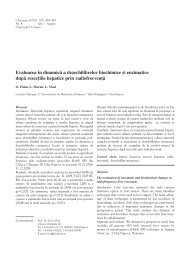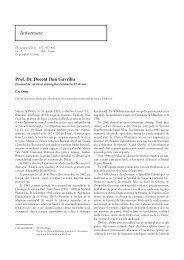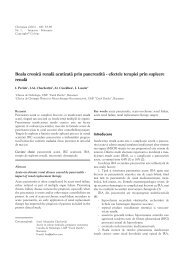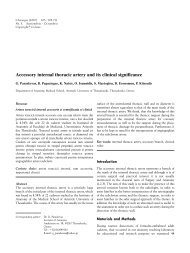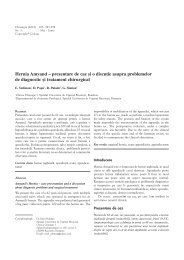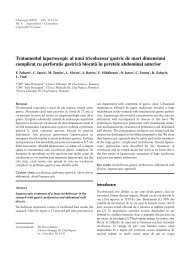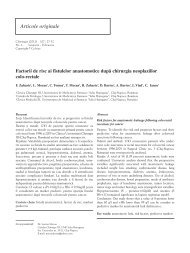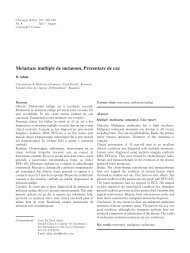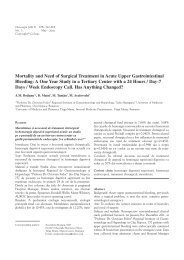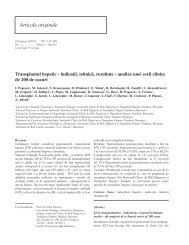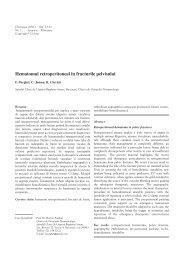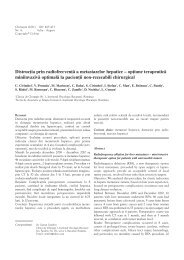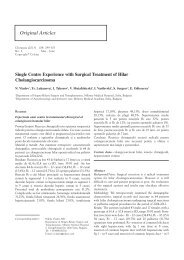Istoria medicinei - Chirurgia
Istoria medicinei - Chirurgia
Istoria medicinei - Chirurgia
You also want an ePaper? Increase the reach of your titles
YUMPU automatically turns print PDFs into web optimized ePapers that Google loves.
569operative results. A century ago any man suffering frombrain tumor succumbed after suffering overwhelmingheadaches, and sometimes, after having become blind formany months. Any patient suffering from paralysis due tocompression of the spine by tumors, even benign, could notleave his bed where he had to pass very miserable years,before being defeated by painful complications. Manypatients with facial neuralgia felt their pain exasperate somercilessly that suicide was the only thing they could thinkof. For the majority of such patients, the situation inseveral countries began to be reversed (8). So, why wasFrance slow?Since 1926, Vincent was saying to his students, thatthere was a new neurology, born and developed in theUnited States, which he promised to teach them. It wascreated and perfected by surgeons gradually specialized inthe pathology and interventions of nervous system. Helamented that this kind of surgeons did not exist in France.In 1927, he left with Martel to America. Vincent spent sixweek next to Cushing, conquered and succeeded, throughhis intelligence, his seriousness and scholarly courtesy ofPercival Bailey (1892 -?), former student of Pierre Marie inParis, to review the innovative methods of the Americanneurosurgery and many physiological and pathological newfacts that were discovered. Determined already to create andgrow the French neurosurgery, his patriotism compelled him,not to let those who practiced neurosurgery to be satisfiedwith results as imperfect as in the past; however, despite theexhortations of Babinski and Cushing, he was not thinkingyet to operate. After his return to France, and after somenew disappointments, he came to the biggest decision of hislife: “I began to understand, he said one day with frankimmodesty that the mortality is not going to be decreasedunless I operate myself” (9).He was 48 years old, and by then he had never been taughtthe surgical gestures, but he was a prominent and admiredneurologist. But what mattered to him was the safety of thissituation! He now had a new master and model, Cushing.With the progress he was making to this application, he wasonly thinking of handling stitches, sutures, ligatures andseparations, which he repeated a thousand times. The scholarwas becoming craftsman.Vincent knew nothing of the magnificent work of Cushingwhen he saw the author; but what he especially learned wasthe precautions of delicacy, detail, perfection of haemostasisand suturing, which must be taken to act without harming andoperate as a master. Achieving haemostasis is easy in generalsurgery. The necessary instruments, clamps and ligatures areusually easy and harmless; but, in the case of the brain, thiscould be a harmful and rough process. Cushing had inventedthe clips, very small metal staples tight on the vessel that isbleeding and left there. He also invented in neurosurgery, theuse of electrocoagulation in bleeding vessel. Progress herecould, at first glance look like a setback (8).In Boston, Vincent watched and understood everything,and in turn he seduced for the quality, the fixity of hiscuriosity, his enthusiastic receptivity, relevant observations, hisadmirable knowledge of brain and lesions. Cushing operated hispatients having around him all of his assistants, gathered in alarge cohesive team and being happy to obey such a leader.Having learned during this first trip, the value of adiagnosis more accurate than those which he already knew todo, and the number of specialized collaborators that a neurosurgeonmust at all costs obtain for help, if his ambition is theperfect clinical and proper preparation of the patient beforethe surgical procedure: having seen how the cerebral hemispheresshould be treated, differently than ordinary tissues, ifthe surgeon prefers to be itself, more than a manoeuver, abrain, it had not yet led Vincent to the desire of operatinghimself or doubting about another; but since his return, he wasnever to stop thinking to the incomparable satisfaction thatawait anyone whose knowledges unite the science of diagnosisof a great neurologist and the consumed art of a perfectoperator. The most skillful man in the world, if he ignoresthe anatomy of the brain, the reactions of this organ to theslightest injury he will always be intruder (1).Vincent became a neurosurgeon shortly before turning 50years old. Why had he thought of this new orientation afterthe halfway of his life? What virtues or what intentions hadtruly inspired and would lead to this impressive mutation of aperson in his fifties?Disappointed by the results of the French neurosurgerywhich remained seriously back comparing to those obtainedand published by foreign surgeons, he decided to take thescalpel himself, not without measuring the risks though.So, Vincent expected to be both the person who is responsiblefor the diagnosis and who handles the surgical instruments,the scholar and the craftsman as well. This sudden andsurprising decision pushed him away from Thierry de Martel,who had been the most ardent neurosurgeon of his time inFrance and had already formed excellent assistants. Thisrupture, during which there where shrill phases, put a darkcloud on the development of neurosurgery in Paris and on thedestiny of each of the two former friends too.The year 1928 was very important for Vincent; he beganto operate and also published a report on tumors compressingthe frontal lobe, in which he could state, on a personal statisticsof fifteen cases, thirteen accurate diagnoses, or in 86% ofthe cases. We must mention, what Vincent rarely said, thatMartel had healed six patients out of thirteen, a number lessdisappointing than one could suppose. In his clinical picture,Vincent attempted to do for the frontal lobe, what Babinskihad done for the cerebellum; the meeting of the lessunfaithful signs in a striking syndrome. Instead of following theclassic grouping, psychic signs, balance disorders, coordinationand mime, he proposed the following triad added to the signsof cranial hypertension: facial paralysis of the central type,more or less pronounced aphasia, early mental health problemsclearly represented (8).Vincent, initially helped by surgeons operated successfullyhis first patient, who had been diagnosed with intracranialhydatid cyst; that day, Vincent had requested an expertsurgeon to incise the scalp and lay the cranial flap; then he didhimself the particularly delicate part of the actual brain
572DiscussionThe death of the person, who always seemed so tenacious,was a painful surprise. However the sorrow of his losslanguished, because of all that would still have to give thereal genius of the clinician and the prodigious courage of theexplorer, if Vincent had watched his own health as he didthe other people's health, can not prevent from the fulladmiration of the extraordinary adventure that his life was,giving him a place among the greats.The future generations will not ignore what they owe tohim on scientific papers, models of sincerity and reason andnew surgical procedures. He created a bright school, provideda place of world renowned research and remained, in science,an example of investigative rigour, showing the French contributionto a magnificent advance in medicine and surgery.It is one of the neurologists who has most insisted on thecautiousness of the diagnosis, sometimes too systematic, ofsyphilis in diseases of the nervous system.He did not write books but published numerous articlesin the Neurological Journal (Revue neurologique), theMedical Week (Semaine médicale), the Journal of surgery(Journal de chirurgie), etc. His report on frontal lobe tumorsis fundamental.His name is linked to a clinical sign "sign of Vincent" veryprecise and subtle at the time, which gives many information,according to the study on the deglutition, on the instinctiveconsciousness of the injured in the skull. His name is alsolinked, among other things, to the "Vincent retractor","Vincent bone forceps", and "Vincent spatula" (6).ConclusionIf we accept that neurosurgery was really born when Cushingproved that the neurosurgeon had to be at the same time asurgeon, a neurologist and a biologist, we will realize thatFrance owes this triple guarantee of recognition for the firsttime to Clovis Vincent.References1. Moreau R. Clovis Vincent. Paris: Masson; 1948.2. Manuila A, Manuila L. Vincent Clovis (1869-1947). In:Dictionnaire français de Médecine et de Biologie. Paris:Masson; 1972. p. 174.3. Vincent C. La Méningite chronique syphilitique. Les lésionsdes nerfs de la base du cerveau. Paris: Éditions Steinheil; 1910.4. Dupont M. Clovis Vincent (1869-1947). In: Dictionnairehistorique des médecins dans et hors de la médecine. Paris:Larousse/Bordas; 1999. p. 567-8.5. Thieffry S. Leçon inaugurale. Paris: Masson; 1965.6. Giroire H. Clovis Vincent. Pionnier de la neurochirurgiefrançaise. Paris: Perrin; 1971.7. Huguet Fr. Vincent Clovis. In: Les Professeurs de la faculté demédecine de Paris. Paris: Éditions du CNRS; 1991. p. 500-1.8. Mondor H. Clovis Vincent (1880-1947). In: Anatomistes etchirurgiens. Paris: Flagrange; 1949. p. 473-30.9. Binet L. Clovis Vincent (1869-1947). In: Médecins, biologistes,chirurgiens. Paris: SEGEP; 1954. p. 285.



